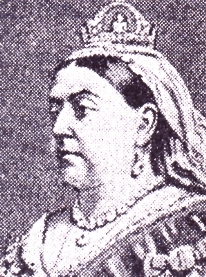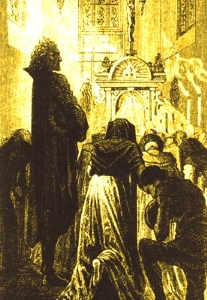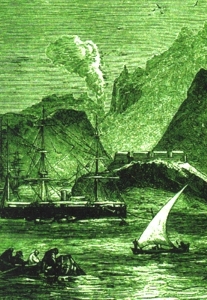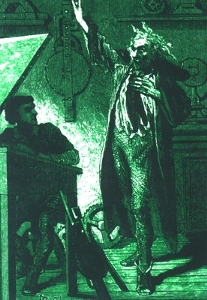![]()
| Proposal 2, Page 6 (continued from Page 5) | |||||
| THE EPISODES | |||||
|
|
|||||
| Episode 1: From the Earth to the Moon | |||||
|
The story opens in the Ural Mountains of
Russia, where Jules Verne is enthusiastically researching his next
bestseller - "Michael Stroganoff. His friend, Phileas Fogg, the
famous English gambler is with him, and Fogg's manservant, Passepartout,
is doing his best to protect his master from the discomforts of rural
Russian inns. As
Jules and his friends climb through a high mountain pass, they suddenly
find themselves surrounded by a horde of heavily armed Cossacks, and
despite a spirited resistance are captured, bound and blindfolded. |
|||||
|
 |
||||
|
Jules is just asking himself why the Count
kidnapped him in order to give him an unwanted lecture on politics, when
he's taken up to a thickly wooded defile high above the lodge - and sees
something that stops him in his tracks. It's
the giant gun he invented to shoot a projectile into space in his novel
“From the Earth to the Moon.” The Count has used his immense
resources to actually build what Verne had only dreamt of - but instead
of pointing it towards the sky, he had aligned the gun directly towards
St Petersburg - and filled the projectile with high explosive. Count
Kulkov intends to blackmail the Tsar into calling off his reforms - or
facing the destruction of his capital and all its treasures. He's hit a
technical snag in the completion of the gun, and hearing that Jules is
visiting Russia, has decided to enlist his assistance. If Jules doesn't
co-operate, it's all too clear that Natasha will bear the brunt of the
Count's anger. If he does, however, reform in Russia will grind to a halt and the nation will remain mired in the middle ages.For the first time Jules comes face to face with the chilling prospect of his own imaginings becoming reality. But with the help of Natasha and his friends, he not only manages to turn the tables on the Count - but to put his own theories of space-travel to a practical test: with the reactionary aristocrat as the first, unwitting astronaut |
|||||
| Episode 2: Nemo and Me | |||||
|
On
a journey to the Hebrides, the boat in which Jules Verne and his friends
are traveling becomes lost in the mist, and they find themselves on a
fog-bound island from the interior of which come strange and unnerving
noises. |
|||||
|
 |
||||
|
What Jules left out of the published
version, however, was that Captain Nemo was accompanied by his beautiful
daughter Laura - and that even as he was marveling over the amazing
machine Nemo had created -Jules was also falling in love with her. At
which point - the island is invaded. News
of the Nautilus has reached the ears of none other than Prussian
Chancellor Otto von Bismarck, who realises that a fleet of
submarines is just what Prussia needs to destroy the British Navy
- and make Kaiser Wilhelm the undisputed ruler of Europe. In a desperate battle of wits, Jules and his friends do battle with Bismarck and his men to save not only Nemo and Laura - but the world from a weapon of war for which it is not yet ready |
|||||
| Episode 4: Through Time, Part 1 | ||
| With
money from one of Phileas Fogg's gambling coups, Verne builds a
"Chronological Displacement Device" that allows him to travel
through time and return to his days as a struggling young writer in the
Paris of the 1840’s.
Ater a pyrotechnic display of electric power they find themselves in the middle of a wild parry with Verne's old mentor, Alexander Dumas, who is suffering, uncharacteristically, from writer's block as he labours on his current historical novel. |
|
|
|
|
He's
therefore quite amenable to what he assumes is his young friend's
whimsical suggestion - that he join them on a trip into the past he's
trying to write about the seventeenth century. On
their arrival in that turbulent era they find themselves, almost
immediately caught between the troops of the evil Cardinal Richilieu and
a stalwart group of soldiers known as the Musketeers. Suddenly, Dumas
has the inspiration he's been looking for. |
|
| But not before the Cardinal's men have grabbed the Chronological Displacement Device and made off with it - so that only the intervention of Athos, Porthos, and Aramis can save the duo of great authors from being stuck forever in the world of Louis XIV. In the resulting melee, however, not only do they accidentally make off with the Queen's necklace - but the Three Musketeers along with them are carried into an unknown future. | ||
| Episode 5: Through Time, Part 2 | ||
|
Verne,
Dumas and the Three Musketeers trying desperately to control the damaged
time machine, aim for the nineteenth century - and overshoot, finding
themselves in a classic French chateau near the Normandy coast But for
some reason it's full of Germans with strange weapons and even stranger
uniforms... |
|
|
|
With some difficulty and considerable
danger - Verne and his friends work out what's happened: they're in Nazi
occupied France in June 1944 - and the Resistance movement has a use for
them. The chateau is the headquarters of the German General Staff in
Western France - and a target for a major raid by the real-life
equivalent of the Dirty Dozen. A raid which needs inside help - and
which also, even when our friends give that help, goes badly wrong. How Verne and the Musketeers save the Allied commandos and prevent the failure of the Allied Invasion of Europe, is the subject of one of the most extraordinary and spectacular of Verne's adventures. |
||
| Episode 6: Journey to the Center of the Earth | |||||||
|
Verne
and Fogg are examining newly discovered cave paintings by pre-historic
man in caves in southern France when they come across a clue which leads
them to believe our ancestors explored much deeper beneath the surface
of the earth than anyone had previously realised. |
|||||||
|
|||||||
|
At
last, as a result of an accident, they plunge THROUGH the wall of one of
the tunnels and find themselves falling an incredible distance -
plunging, they're certain, to their doom. Until a strange, leaf-like
flying device sails out of the gloom to rescue them and they find
themselves gazing on the luminous-skinned descendents of... Neanderthal
Man.
When
they finally come to rest they discover an entire civilisation deep
beneath the Earth's crust, consisting of the people evolutionists have
long considered extinct because of their disappearance from the fossil
record. They learn that instead of fighting it out with Homo Sapiens,
their more aggressive competitors, the Neanderthals fled underground and
made their way, year by year, ever deeper within the cavities of the
planet
There,
like their brethren on the surface, they evolved a developed
civilisation - a much more gentle and peaceful civilisation than ours
and one which Jules and his friends realise could be destroyed in an
instant by any contact with the world above. |
|||||||
|
Episode 7: Queen Victoria and the Giant Mole |
|||||
|
Verne and his friends are being shown around a steelworks by Valerie Vaudremont, the daughter of the industrial magnate, Victor Vaudremont. Valerie, an ardent Jules Verne enthusiast, is keen to show him what REAL technology and science have achieved while he's been making it up. As well as wanting to increase his knowledge, Jules is clearly charmed by Valerie herself and there's a flirtatious element to the tour. |
|||||
|
|||||
|
They
fall to the ground and when they regain their feet they are looking at
the metallic nose of a bizarre vehicle which has risen out of the earth
itself - a giant Mole. Even as they watch, masked and black-clad men
pour out of it and begin dismantling the milling machine and
transferring the parts into the interior of the Mole while holding
factory workers at bay with devices that look like early versions of the
modern machine gun. Valerie, who is nothing if not courageous, hurls herself at the nearest intruder, “How dare you take my father’s machinery!” and tears off the man's mask - disclosing a handsome, moustached face beneath. The man swiftly covers his face again, but, because Valerie has seen him, he orders her thrown into the interior of the Mole. As a result of which Jules hurls himself into the fray, and despite Fogg and Passepartout's best efforts, he too is captured. Seconds later the hatch is closed, the screws are turning in reverse, and the Mole is disappearing the way it came, filling in the tunnel behind it |
|||||
|
Inside their metal chamber, Jules and Valerie try desperately to escape as the machine grinds its way through the earth - but in vain. When their hatch finally opens they're in a vast underground cavern full of stalactites and stalagmites, where dozens of black-clad men begin reassembling the stolen machinery to produce the parts they need to perfect the Mole They're hustled
through the busy scene until they're face-to-face with the hawk-nosed
man whose mask Valeric tore. He introduces himself as the Comte de
Gondreville, the creator of the Mole. Gondreville is a super-patriot, full of chagrin at the way that France has been eclipsed by the British Empire and determined to use his invention to strike back But when Verne and Valerie challenge his chauvinistic assumptions and demand to know what he intends to do, they're hustled away and locked in a store-room |
 |
||||
|
Back in the factory, Fogg and Passepartout, together with M. Vaudremont, Valerie's distraught father, are trying to work out how they can track the Mole back to its point of origin, frantically studying maps of the geology of the area to guess its likely path. In
the midst of the understandable consternation caused by the appearance
of the Mole, the Comte's men snatch Queen Victoria, bundle her into the
machine, and burrow back into the earth. Their plan? To hold the British
monarch hostage until Britain cedes the Suez Canal back to France. How Jules Verne foils this plan, averts war between two great powers, and pilots Valerie, himself and Queen Victoria back to Napoleon's ball, provides the finale to one of the celebrated author's most enjoyable adventures |
|||||
|
Episode 8: The Crypt |
|||||
|
Jules and his friends are traveling to the country home of a widowed aunt when they're caught in the midst of the most violent electrical storm in living memory. Soaked and shaken, they reach shelter, where Jules' attractive relative quickly restores them to warmth, dry clothes and good spirits -especially Phileas Fogg, with whom she forms an immediate rapport. When the sun comes out the next day and they're sitting in the garden enjoying the peace of their rural surroundings, they're interrupted by an extraordinarily violent tolling of the local church bell. When they look at the church, just visible across the fields, the building is surrounded by pulsing blue light. Minutes
later, they see frightened peasants hurrying along the roads away from
the church and minutes after that, they are visited by an anxious
figure, Pere Moriot, the parish priest. |
 |
||||
|
|
|||||
|
He
says he has come to ask a man of science for help uncovering the
mystery. Jules and his friends go to investigate and find a parish
church, complete with a tomb-crammed crypt, that is, to all appearances,
perfectly normal. The Helmet of St Bartholemew is back in its place
below the altar, largely obscured by the elaborate relinquary in which
it had been placed. There is no sign of any supernatural phenomena. Jules
begins to ask questions about the relic and Pere Moriot consults the
records: it came to the church in 1124, having been brought back from
the Crusades. The date rings a bell in Jules' mind, and he returns to
the crypt where he noticed a tomb bearing the same date. A knight's
effigy is carved on the tomb and the inscription reveals it to be the
last resting place of the Vicomte de Beauseant, the local lord of the
manor who, according to the records, brought the Helmet of St
Bartholemew back from the Holy Land. Jules returns to his Aunt's house with all the books he's been able to gather about the Vicomte and his adventures during the Crusades. As Phileas Fogg flirts agreeably with his new friend, Jules searches for clues in the legends of the Vicomte in the Crusades for the origin of the Holy Relic. In the course of his reading he discovers that the Vicomte was lost for several months in the mountains of Syria, where he went in pursuit of a shooting star that appeared to have landed there, and that when he returned he brought with him not just the Holy Relic, but a man-sized casket he refused to show anyone. What happened to the casket no one knows. But Jules has his suspicions. He secretly returns to the church at night with Fogg and Passepartout, creeps into the crypt, and opens the Viscomte's tomb. At first he thinks he's simply uncovered the remains of a knight in full armour. But when he lifts the visor of the helmet he uncovers a face which is not of this world. An alien creature stares up at him with long-dead eyes... or ARE they long dead? Jules is about to find out, because at this moment, in the church above, the Helmet of St Bartholomew rises once more from its place below the altar, the walls of the building begin to pulse, and the alien in armour rises from his sarcophagus to stalk our heroes through the church. Only when Jules realises the true nature of the Helmet of St Bartheolemew, and what it means to the alien, will he be able to save himself and his companions and rid the church of the terror which, without his intervention, would have emptied it forever. To say nothing of rescuing a lost space traveler from an eternity of entombment and sending him back on his way across the cosmos. |
|||||
|
Episode 9: Journey to the Bottom of the World |
|||||
|
 |
||||
|
Tunnels which have clearly been cut by
some object capable of generating immense heat Tunnels which lead them
to the Pole itself. Beneath which, in an environment reminiscent of the interior of Nemo's "Nautilus", they find Jean Jacques Robur - one of France's most brilliant scientists. Robur has discovered - without fully understanding it - the fissile property of uranium, and used it to BURN his way to the centre of the Southern continent Now he intends to employ this same technology to melt the entire ice-cap and create a great new domain for France. In vain do Verne and Fogg try to persuade him of the catastrophic consequences of such an experiment - of the possibility not just of massive flooding around the world as sea-levels rise - but that the earth might begin to wobble so violently on its axis that it begins to disintegrate. But Robur is determined to go ahead with his scheme - and only a desperate battle beneath the ice can save the planet. |
|||||
|
Episode 10: The Land Ironclad |
|||||
|
Jules
Verne and Phileas Fogg find themselves on a train in America with a
brilliant and energetic young news vendor named Thomas Edison, who makes
his living selling food and self-printed journals to the passengers. The
Civil War is well under way, and the boy is convinced it's his destiny
to invent a great weapon which will end the conflict. Jules
tries to dissuade him: he can see that Edison has the spark of genius,
and he urges him to turn it to higher goals than killing - like
communications, for example. But Edison has all the enthusiasm of youth,
and showers Verne with his drawings of a brilliant steam-driven tank -
drawings which fill the young author with foreboding. The
situation alters dramatically when the city into which the train pulls
is suddenly besieged by Southern troops and a Northern spy with urgent
dispatches for Washington is trapped there. Under Edison's urging, and
with great reluctance, Jules and his friends agree to help Edison build
the tank to break through the Southern lines and get the dispatches out |
|||||
 |
|||||
|
With great ingenuity they manage to put together a crude, unreliable and dangerous prototype of the machine under bombardment from Southern guns: though the situation does not prevent Phileas from striking up a romance with a beautiful young woman who sees the freeing of the slaves as only the first step towards the emancipation of all mankind - including women. At last the tank is ready, and with great daring Jules and his friends try to sneak it out through the Southern lines. But they're surprised and come under attack by a brilliant General named Hawke, and are obliged to demonstrate the fighting capacity of the tank to save themselves In the carnage that follows, Thomas Edison is brought face to face with the havoc that his inventive genius can wreak, and resolves never to build a weapon of war again. Think about going into the illumination business," advises Jules, as Edison and the Northern Spy are brought to safety. There's a great future in that" But even though Edison has been set on the right path and Washington given the warning it needed, Jules’ troubles are not yet over -because Hawke, realising the immense potential of the tank, comes after it, determined to add the weapon to the Southern arsenal. He almost succeeds in capturing it, and Jules and his friends have no option but to drive the tank into the wilderness, trying desperately to keep it out of Hawke's clutches. When they find themselves trapped at last on the banks of the Mississippi, Jules resolves there is only one way to keep the tank away from the pro-slavery forces: he must drive it, almost certainly at the cost of his own life, right into the river. In the last image of the episode, the Land Ironclad disappears under the rolling waters of "Ole Man River." |
|||||
| Episode 11: Nemo of the Mississippi | |||||
|
|||||
|
Only the intervention of a Mississippi river boat saves them - and they find themselves face to face with the river pilot who would one day become famous as the author Mark Twain. But
the tide of the Civil War has now swung towards the Mississippi, and the
Confederate Navy commandeers the riverboat to use in a deadly bid to
break through a Yankee blockade: a bid which will almost certainly end
in the boat's destruction and the death of most of those on board. Fogg
- who's in his element among the gambling fraternity on board - is
determined to prevent this happening: but apparently faces overwhelming
odds. When he gets news of the sighting of a mysterious sea-monster in
the vicinity of New Orleans, they realise that their old friend Captain
Nemo is in the vicinity. And suddenly the entire situation changes... |
 |
||||
| Episode 12: Gunfight at the Robot Corral | |||||
|
Verne's
adventures in the West continue as he and Fogg leave the Civil War and
head for the frontier. Among Fogg's winnings aboard the riverboat was a
map purporting to show the whereabouts of a vast cache of Aztec treasure
spirited away from the beseiged Mexican capital during Cortez'
final
assault, and now supposed to be hidden in a sacred Indian burial ground
somewhere near the Grand Canyon. |
|||||
|
|
|||||
|
But Verne and partners aren't the only searchers after the treasure. Turns out that the gambler who put it up as his stake in the game with Fogg has done this SEVERAL times before. And one of the gangs out searching for the treasure is led by two dangerous young men called Frank and Jesse James... Before
long Jules, Fogg and Passepartout find themselves being hunted through
the west by the James Gang - and hiding out in a blacksmith's shop in a
western town whose citizens are too terrorised to lift a finger to help
them. But it’s in this blacksmith's shop that Jules uses his brilliant imagination to save them - when he invents and builds the world's first robot gunfighter: a clanking, steam-driven monster who stalks out into the dusty main street to shoot it out with the James Brothers in the strangest gunfight the Wild West ever saw. After which, of course, our heroes can get on with their quest for the lost gold of the Aztecs |
|||||
|
Episode 13: The Strange Death of Professor Marechal |
|||||
|
While attending
the funeral of his old friend Professor Pierre Marechal, Jules Verne is
asked by the professor's lawyer if he would honor the old scientist's
memory by taking a package out to his country home. Jules readily
agrees, and the lawyer shows him his instructions, which stipulate that
the package must be delivered within twenty-four hours. He's
somewhat taken aback when he goes to collect the "package"
from the professor's home and discovers that it is, in fact, a crate,
and that the professor's “country home” is an island off the coast
of Brittany. But nevertheless, accompanied by Fogg and Passepartout, he
sets out on his mission. In fact, he knows of this island. Until now its main claim to fame has been an extraordinary tidal phenomenon which creates whirlpools of great intensity. When they reach the coast, it is shrouded in mist, but a boat sent by the Professor appears out of the fog to collect them. |
 |
||||
|
After
an unnerving voyage with a huge, silent boatman, they land on the island
and half a dozen similarly uncommunicative servants take the crate and
march off with it through the fog. Jules and his friends are taken to
what appears to be the uninhabited ruins of an ancient monastery. When
they go inside, however, they discover that the interior has been
converted into a sumptuous residence. Mute
servants wait on them, providing them with hot baths and luxurious
accommodations, but ignoring all their enquiries. As night falls they
are escorted to their rooms with promises that the boat will take them
back to the mainland tomorrow. Jules being Jules, of course, he's not prepared to leave the mystery undiscovered. As soon as the household has fallen silent he tries to leave his room to explore the premises - the door is locked. Nothing daunted, he manages to lever open the window and climb out onto the crumbling stone of the monastery wall. Far below, the waves crash on the distant rocks. And three feet away, there are Fogg and Passapartout, also spreadeagled against the wall, escaping from THEIR rooms in precisely the same manner. Greatly daring, Jules and his companions find their way down to the caves beneath the monastery, which are filled with strange and gigantic devices which Jules realizes must be turbines to generate electricity, though what makes the turbines turn is beyond him. Thick cables lead from the generators to a shaft in the wall, and when Jules looks up he can see stars -whatever the generator is powering must be high in the roof of the monastery. Silently,
the three men creep up through the ancient building until they reach a
winding stone stairway leading to a long gallery. At the end of this
gallery is a passage guarded by a massive door. Beyond the door is a
huge, dome-like chamber. An amazing sight greets them in the center of the chamber: a massive cylinder, studded with bolts and covered in electric coils, around which the servants are busy at work The remains of the crate they brought to the island lie scattered on the floor. Verne and his companions slip into the shadows to observe more closely - and then their hair stands on end. From outside the chamber they hear an unearthly noise. And when they're able to look down from one of the open vaulted windows they see, down below, flickering with luminescence, the strange tidal phenomenon Jules knew about, with ferocious whirlpools opening up in the otherwise calm sea and powerful jets of water forced through crevices in the rocks. As this phenomenon reaches its height, another sound rises from deep in the bowels of the island: an immense thumping, as if some superhuman creature is trying to break out from the confines of the earth. "The Generator"! At which point the cylinder behind them seems to come to life, its coils pulsing with light and great arcs of electricity surging around it Almost paralyzed with fear, Jules and his companions watch as strange, unnatural colors appear through the thick glass port-holes along the side of the machine. And
then it begins to open - and to their superstitious horror, a figure in
what looks like a diving suit rises from the interior, wreathed in
clouds of dry ice and slowly removes its helmet It's the professor, whose funeral they attended less than twenty-four hours before, deathly white-skinned, cadaverous - but alive. For a long moment he looks at them - and then, it seems, something stirs in his memory and he speaks, not in the voice they remember, but in a strange, sepulchral tonality that sounds as if it comes from another world He invites them to join him for dinner. Half an hour later they are being waited on in the dining hall, with the professor, now wrapped in voluminous robes and looking a little more human, presiding over the meal. He reveals that he has been experimenting for years for a way to use electricity to conquer death, beginning with small animals, going on to livestock purchased from slaughterhouses, and finally graduating to humans. His method was to approach people with incurable diseases and offer them money for their families in return for the right to experiment on them after death. Although he had many rejections, he also had many acceptances - after all, he was offering dying people the prospect of life. Gradually his abilities improved. His earlier subjects, although they returned from the dead, did so as little better than zombies, and even later subjects, though able to function, are silent, strange creatures, unwilling to speak It is they who act as his servants here on the island. But when he learned that he himself faced death, Marechal decided to throw all his energies into perfecting his system so that he might return as a fully functioning human. And
tonight, thanks to Jules, he's been able to achieve that Jules is
fascinated - but horrified. Doesn't the professor realize that what he's
doing is wrong? Playing God with people's lives? Marechal is furious at Jules' defiance, and we begin to realize that though he appears to have come through the death experience unscathed, he is in fact on the edge of derangement He screams at Jules that he's redefining the possibilities of human life, pushing back the boundaries of death and he's determined that Verne, world famous as he is, will trumpet his triumph to the world. They
flee through the ruined monastery, pursued by the zombies, until they're
trapped, up in the chamber where the revival took place, for the
climactic battle - at the height of which, the professor slips and falls
back into the open cylinder. At which point, the tide turns, the unearthly noises echo up from the caves below and the turbines in the bowels of the monastery begin to turn once more. Within minutes, and before Jules can do anything about it, the entire group has turned to dust, a wind has sprung up, and the dust is being blown out of the window and over the sea. Jules looks at his friends, “This is one extraordinary voyage,” he says, “about which I will not be informing my public.” |
|||||
